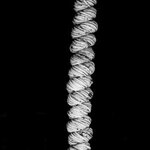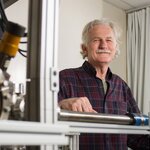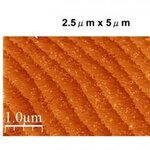Applied Physics

Researchers have used fishing line fiber and sewing thread to create inexpensive artificial muscles. The inexpensive, artificial muscles generate far more force and power than human or animal muscles of the same size and could be used in medical devices, humanoid robots, prosthetic limbs, or woven into fabrics.
"In terms of the strength and power of the artificial muscle, we found that it can quickly lift weights 100 times heavier than a same-sized human muscle can, in a single contraction," says University of British Columbia Electrical and Computer Engineering professor John Madden. "…

Goodbye Ohm - Hello Heisenberg
Research reported earlier this month shows that electrical resistance in
nanoribbons of epitaxial graphene changes in discrete steps following
quantum mechanical principles.
In plain language, electron transport in a new variant of graphene doesn't obey Ohm's law: the resistance of the material is independent of current. However, unlike the case with a normal conductor where you can stick a multimeter across any two points on a wire and measure the voltage, if you probe this new material you increase the resistance. Shades of Heisenberg.
Walt de…

The discovery of what is essentially a 3D version of graphene – the 2D sheets of carbon through which electrons race at many times the speed at which they move through silicon - could lead to much faster transistors and far more compact hard drives.
Researchers at Lawrence Berkeley National Laboratory have discovered that sodium bismuthate can exist as a form of quantum matter called a three-dimensional topological Dirac semi-metal (3DTDS).
This is the first experimental confirmation of 3D Dirac fermions in the interior or bulk of a material, a novel state that was only recently proposed by…

Peregrine falcons are one of the world's fastest birds, reaching up to 200 miles per hour when diving.
Scientists are studying the body shape and wing contour of the bird to better understand how they reach these high diving speeds while maintaining maneuverability - in human planes, flaps slow you down to make the aircraft more maneuverable.
Researchers trained peregrine falcons to dive in front of a 200 foot dam and captured 35 dives with a stereo high-speed camera system and hi-res camera. The images allowed researchers to reconstruct the flight path and body shape of the falcon…

Stampedes occur often, and not just in wild animal herds. Previously, physicists developed numerous models of crowd evacuation dynamics based on disasters such as the yearly Muslim Hajj or of the Love Parade disaster in Germany in 2010.
If crowd dynamics models were used for evacuation routes in those casualties, they weren't very good. A new study in EPJ B outlines a procedure for quantitatively comparing different crowd models, which also helps to compare these models with real-world data.
The trouble with models is that they use inputs, real-world data, of crowds that is limited and…

You learned in high school that light has a dual nature - it exists as both waves and photons. It is this duality of light that enables the coherent transport of photons in lasers.
Physicists know that, at the atomic-scale, sound has the same dual nature, existing as both waves and quasi-particles known as phonons. Knowing that, phonon-based lasers have also been in development since the first functioning laser was created in 1960, with limited success.
Arun Majumdar, VP for Energy at Google, and Ramamoorthy Ramesh, a senior scientist with Berkeley Lab's Materials Sciences Division,…

This build is a simplified Leeuwenhoek microscope made from CD-ROM drive parts and construction toys. My initial design was simply a rectangle of corrugated cardboard with a hole punched in it and one of the glass spheres from the Chem C3000 kit, but the magnification was disappointing and the field of view surprisingly narrow. Another method would have been to demonstrate melting a glass rod, drawing it to a thin glass fiber and then heating the fiber into a glass sphere. Though this would have been historically appropriate, it might be difficult to find this type of glass rod and they might…

Heat engines transform heat into mechanical energy with the corresponding efficiency of an Otto engine amounting to only about 25 percent, which is what your automobile gets.
The efficiency of heat engines powered by thermal heat reservoirs is determined by the second law of thermodynamics, one of the fundamental concepts in physics. It was as far back as 1824 that Frenchman Nicolas Carnot calculated the maximum possible efficiency limit of such engines, now known as the Carnot limit.
Now imagine a heat engine that consists of just a single calcium ion. Such a nano-sized heat engine would be…

When E. F. Thompson stood on the deck of a ship cruise ship the Indian Ocean in the 1930s and observed a dolphin speed past the vessel in 7 seconds, he had no idea that this single observation would lead Sir James Gray to formulate the enduring paradox that bears Gray's name to this day.
Based on Thompson's anecdote, Gray estimated the power required to propel the boisterous mammal through the waves at 20 knots (10.3 m/s) and concluded that the animal did not have enough muscle to pull off the feat. Puzzled by the paradox, Gray concluded that dolphins must use a trick of fluid mechanics…

What would make snakes scarier?
For spiders, the answer is easy. If you see one big enough to be feasting on Orc flesh in the caves under Mt. Doom, run, but snakes are tougher to make scary because they are slow.
Not all of them. Snakes may not look aerodynamic but some snakes can fly - literally. They slither in air, creating an S shape as they glide as much as 90 feet.
But how do they generate the lift to stay airborne? Jake Socha has spent much of his career figuring out flying snakes and says "They look like they are swimming. They turn their whole body into one…